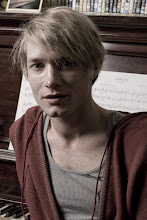I haven't made much of a secret about the fact that I quite like Michael Haneke (see here and here), and it was with a great deal of expectation that I chugged myself off to see his latest The White Ribbon, thrilled to find that it was still playing in cinemas after I somehow managed to completely miss the fact that it released, oh, four months or so ago, despite the fact that I've been hanging out for it since it won the Palme d'Or back in May last year, beating A Prophet down to the Grand Prix (which has got to be one of my favourite films of my hundred odd so far in this marathon.)
The White Ribbon takes place in a small German town in the lead up to the outbreak of WWI. It's quite a difficult film to describe the plot of without either giving too much away, or becoming incredibly verbose. It is effectively a microcosm of society and humanity - there are powerful beings who show heart, innocent beings who (perhaps) show malice, death, love, destruction, hope and sorrow. A pastor is cruel to his children. A baron show sympathy for someone who destroys his crop. A doctor molests his daughter and abuses his mistress. But, in true Haneke style, they all have opposing forces of good or evil playing out within them. And the narrative is plagued by strange, dangerous things happening - a wire strung between trees tripping the doctor's horse as he rides home; the baron's son being strung up and tortured; the pastor's pet bird being impaled. Is it the children?
The film is black and white, shot by Christian Berger, who also lensed Hidden and The Piano Teacher and picked up an Oscar nomination and just took home the ACS award for his work. While much of the work is great, I thought the fact that it was shot colour and then monochromed in post detrimentally affected the quality of the visual tone - the blacks seemed a little brown, the shadows not as sharp as I really think they should have been. I've done this before myself, and I have never thought it looks as good as when you shoot it black and white, so I'm actually a little puzzled as to all the notice... and I should note that I only found out that it was shot colour after making this opinion of the look, so it's not a situation where I went into the film with my opinion coloured (boom boom.)
The acting was fairly fantastic from all of the cast, especially the children, many of whom were quite young. Haneke kept them all in check, reigning them in to fit the familial and social sensibility of the day - emotional externalisation wasn't really the norm in the early 1910s.
But still... I actually thought when I emerged from the darkened theatre that something might have gone over my head, maybe I don't know enough about European history at the time and there was some important subtext that I didn't understand. This may be the case, or I might not have been paying enough attention to the subtleties, or I might actually just be stupid. But I'm familiar with Haneke's work - maybe that was it. I know I was waiting for something confronting, a shocking scene, that never quite came, and this may have tempered my ability to be overly confronted by what was going on bit by bit, which in retrospect is quite full on.
Actually, writing this now, I really want to see the film again. I'm going to give it 3.5 stars for now, because that's where I'm hovering, but when it hits DVD I'll check it out and maybe my opinion will change. Today, though, I'm hoping for an Audiard win for The Prophet on Sunday, though apparently the smart money is on Argentinean entry The Secret In Their Eyes, which I have not yet seen.
Subscribe to:
Post Comments (Atom)


No comments:
Post a Comment